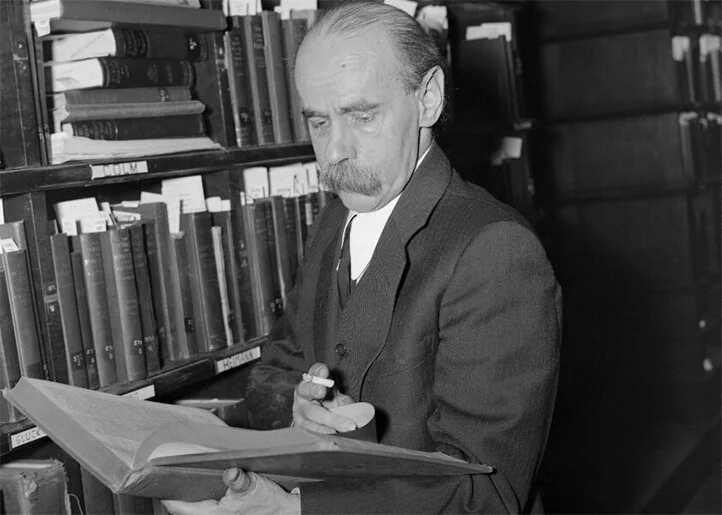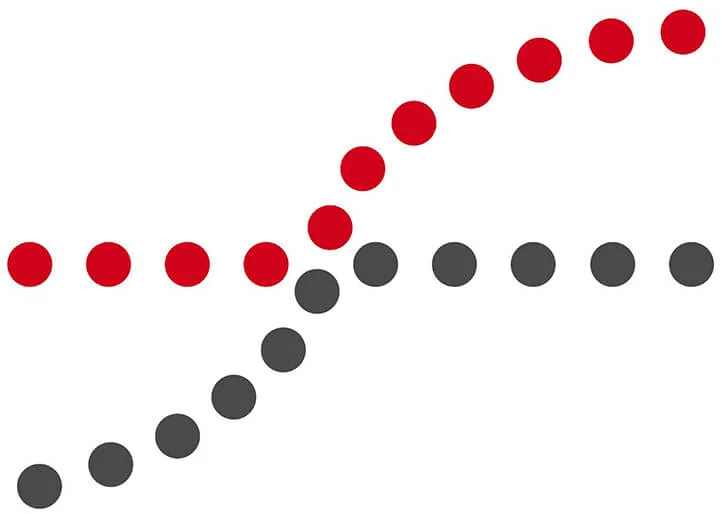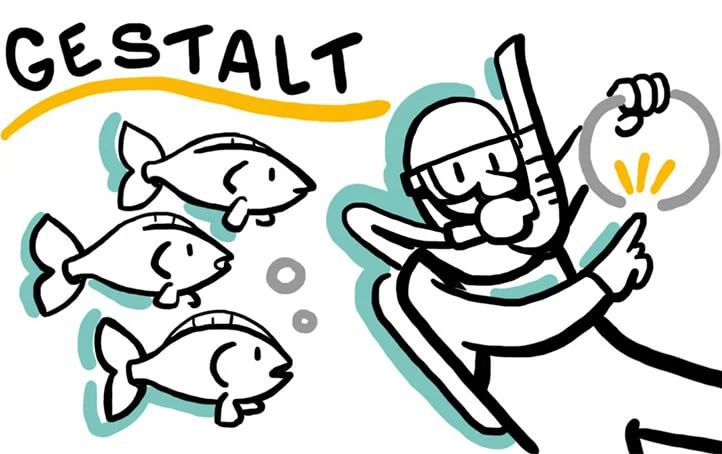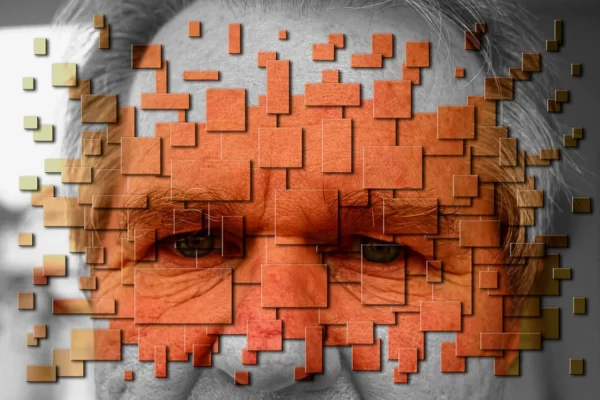Gestalt psychology is a branch of psychology that emphasizes the wholeness of perception and the organization of mental processes, based on the principle that the whole is not equal to the sum of its parts. The history of its emergence dates back to the early 20th century and is associated with a critique of structuralism and associationism, which were dominant in psychology at the time.
It all began with experiments on perception conducted in Germany, which became the starting point for the emergence of Gestalt psychology. One of the key moments was Max Wertheimer’s 1910 study on stroboscopic movement, or the phenakistoscope. This experiment demonstrated that when viewing rapidly changing still images, the human brain perceives them as continuous movement. This phenomenon highlighted the key idea that human perception is based on holistic structures rather than just the sum of incoming stimuli.
This discovery led to a critique of the dominant psychological theories of the time, based on associationism, which claimed that experience is formed by combining individual elements of perception. Wertheimer and his colleagues, Kurt Koffka and Wolfgang Köhler, proposed a new approach to understanding mental processes, focusing on the wholeness of perception. This approach became the foundation of Gestalt psychology.

Main Principles and Concepts
Gestalt psychology attracted many with its unique approach to understanding mental processes. Unlike the traditional theories of the time, which were based on reductionism and the analysis of individual elements of experience, Gestalt psychology focuses on the wholeness of perception.
Under the influence of this theory, psychologists began to explore how people perceive, organize, and interpret information from the surrounding world. The main principles and concepts of Gestalt psychology cover various aspects of perception, from visual illusions to decision-making processes, and they serve as a key to understanding many phenomena in psychology.
The Principle of Wholeness
The principle of wholeness in Gestalt psychology is one of its key tenets. According to this principle, perception, thinking, and all other mental processes cannot be adequately understood by analyzing only their constituent elements separately. Instead, these processes should be considered as holistic structures.
Holistic perception is based on the idea that the mind reorganizes and restructures individual stimuli to create a more complete and meaningful picture. What we see and perceive often exceeds the simple sum of its parts. For example, a series of still images played quickly in succession is perceived by us as movement—a phenomenon that cannot be explained by considering each image individually.
Wertheimer, one of the founders of Gestalt psychology, expressed this understanding by stating: “The whole is not equal to the sum of its parts.” This principle permeates all of Gestalt psychology, providing a new way of understanding human experience and perception.
The Principle of Closure (Incomplete Gestalt)
The process of closure is one of the central ideas in Gestalt psychology related to how people perceive and organize information. This principle relies on the human mind’s tendency to close and complete incomplete or fragmented images, forming a holistic perception.
An incomplete gestalt, or “unfinished task,” refers to the idea that when some task or experience remains incomplete, it continues to occupy our attention and creates psychological tension. This tension motivates a person to complete the task to restore psychological balance.
In the context of Gestalt therapy, this principle has particular significance. Unfinished business, emotions, or conflicts from the past can “hang” in a person’s consciousness, interfering in the present. Gestalt therapists work with these “incomplete gestalts,” helping clients become aware of them and bring them to resolution to free themselves from this psychological burden.
Thus, the principle of closure in Gestalt psychology reflects not only the perception of incomplete images but also a deep understanding of how unresolved issues affect a person’s psychological state.
Figure and Ground
The concept of “figure and ground” is another important idea in Gestalt psychology and refers to the way we organize perceived information.
The figure is the part of perception that stands out and attracts our attention. This can be an object, sound, thought, or any other unit of perception. The figure is the central element of our attention at any given moment.
The ground is the context or environment in which the figure exists. It is everything else that is not the center of attention but plays an important role in determining how the figure is perceived.
For example, when looking at a black-and-white photograph of a person against a city background, the person may act as the figure, while the city serves as the ground. If the focus shifts to the architectural features of the city, the city becomes the figure, and the person becomes part of the ground.
This concept emphasizes that perception is not a static process. What we focus on and how we interpret information depends on what is currently the figure and what is considered the ground. The dynamic between figure and ground is constantly changing depending on our needs, interests, and context.
Principles of Perceptual Organization
Gestalt psychology offers a set of principles explaining how we perceive complex stimuli as organized and meaningful units. These principles demonstrate how the human brain prefers to organize and interpret information from the external world.
- The Principle of Proximity: Elements that are close to each other are perceived as a single unit or group.
- The Principle of Similarity: Elements that are similar to each other are perceived as related or unified.
- The Principle of Closure: People tend to “close” open contours or incomplete figures, perceiving them as whole.
- The Principle of Symmetry: Symmetrical objects are perceived as a single whole.
- The Principle of Common Fate: Elements moving in the same direction or at the same pace are perceived as a unit or group.
- The Principle of Good Continuation: Our perception prefers to see objects and lines in the smoothest and most continuous direction, even if they intersect or are interrupted. This means that if two lines intersect, we still perceive them as two separate, continuously continuing lines rather than four different segments.
- The Principle of Common Background: Elements located on the same background are perceived as related.
These principles illustrate how our brain strives to find order and meaning in the surrounding world, organizing information in a way that makes it understandable and coherent.

The History of Gestalt Psychology
Gestalt psychology is an approach that emerged at the turn of the 19th and 20th centuries as a response to the fragmentation and excessive detailism in traditional psychological research of that time. The main idea of this approach is that the psyche perceives the surrounding world as a whole, and individual elements of perception acquire meaning only in the context of the entire image.
This approach was revolutionary in how it rethought perception and cognitive processes. From experimental research in the field of perception to complex philosophies of psychotherapy, Gestalt psychology has left an indelible mark on the history of psychological science.
Founders: Wertheimer, Koffka, Lewin
- Max Wertheimer was one of the central figures in Gestalt psychology. He conducted a series of experiments based on the illusion of movement, which spurred the development of the basic principles of the Gestalt approach. Wertheimer was convinced that perception could not be considered simply as the sum of parts but only as a unified whole.
- Kurt Koffka became another key figure in this direction. His interests covered a wide range of issues in perception, development, and cognitive processes. Koffka authored many works emphasizing the wholeness of perception and the consideration of mental processes in dynamics.
- Kurt Lewin is better known for his contribution to social psychology, but his ideas are also deeply rooted in Gestalt psychology. Lewin developed field theory, which emphasized the importance of understanding the individual in the context of the social environment. His approach to the psyche as a dynamic field, where various forces interact and influence each other, became fundamental in Gestalt therapy.
Together, these three scholars formed the foundation of Gestalt psychology, bringing in key ideas and concepts that continue to influence psychological science and practice.
Differences from Structuralism and Functionalism
Gestalt psychology, structuralism, and functionalism are three distinct psychological approaches that offered unique ways of understanding the human psyche. Here are the main differences between these approaches:
- Structuralism
- Founder: Wilhelm Wundt.
- Main Idea: The psyche consists of elementary parts or “structures.”
- Approach: Use of introspection to analyze and describe the basic components of consciousness.
- Core Assertion: To understand the psyche, it is necessary to analyze its structural components.
- Functionalism
- Founder: William James.
- Main Idea: Understanding the functions and purpose of mental processes is important.
- Approach: Focuses primarily on the practical and adaptive functions of consciousness.
- Core Assertion: The psyche helps adapt to the surrounding world; it is important to understand why certain mental processes exist.
- Gestalt Psychology
- Founders: Wertheimer, Koffka, Lewin.
- Main Idea: The psyche perceives the surrounding world holistically rather than as a sum of individual parts.
- Approach: Emphasis on the wholeness of perception and mental processes.
- Core Assertion: “The whole is more than the sum of its parts.”
Distinctions
- While structuralism focused on the “what?” by breaking down the psyche into its components, functionalism asked “why?” attempting to understand the functional significance of mental processes.
- Gestalt psychology was a reaction against both of these approaches, emphasizing the importance of wholeness and interconnectedness in perception. According to Gestalt psychologists, perception cannot be viewed simply as the sum of parts or their functions; instead, the entire perception must be considered as a whole phenomenon.
The Development of Gestalt Psychology in Europe and America
Gestalt psychology emerged in the early 20th century in Europe and quickly spread to other continents, particularly North America. Let’s look at the key stages of the development of this approach in Europe and America:
Europe
-
- German Origins: Gestalt psychology originated in Germany as a reaction to structuralism and other scientific approaches to psychology. Max Wertheimer, Kurt Koffka, and Wolfgang Köhler conducted a series of studies in the field of perception that advanced the idea that “the whole is different from the sum of its parts.”
- Growth and Expansion: Gestalt psychology became popular in German academic circles, especially at the University of Berlin. Research continued, and the approach became more systematized.
- Emigration Due to Nazism: In the 1930s, due to the rise of Nazism, many European Gestalt psychologists were forced to emigrate. Most of them found refuge in the United States, where they continued their work and contributed to the development of American psychology.
America
-
- Acceptance and Adaptation: With the arrival of European scholars in the United States, Gestalt psychology became part of the American academic scene. This approach quickly integrated with American research and methods.
- Expansion in Practice: Gestalt therapy, based on the principles of Gestalt psychology, became a popular form of psychotherapy in the United States. Fritz Perls, one of the founders of Gestalt therapy, played a key role in popularizing this approach.
- Integration with Other Approaches: While Gestalt psychology remained a unique and separate approach, its principles were integrated into many other areas of psychology and psychotherapy.

Research Methods
The research methods in Gestalt psychology are distinguished by their uniqueness and are based on the principles of wholeness, dynamism, and structure. Based on the belief that the perception and understanding of the world are integrated and structured processes, the methods in this field aim to study human experience in its natural conditions.
Instead of breaking perception into separate components, as was done in other psychological schools, Gestalt psychologists sought to understand how various elements combine into cohesive structures. This approach required the development of specific research methods that could capture the dynamics of perception and understanding.
Experimental Methods
Experimental methods hold a central place in Gestalt psychology. Understanding human perception and thinking through experimental research provided a theoretical foundation for this field.
- Laboratory Research: Many classic experiments in Gestalt psychology were conducted in laboratory settings. This allowed for the control of variables and the observation of participants’ reactions to specific stimuli. Examples include studies on illusions, visual perception, and the perception of movement.
- Problem Situations: The founders of Gestalt psychology often used problem situations to study the thinking process. One of the most famous experiments is the experiment with chimpanzees trying to reach a banana hanging high from the ceiling by using available objects as tools.
- Phenomenological Analysis: Although this method may seem less “experimental” in the traditional sense, it was important for Gestalt psychologists. They analyzed descriptions of their own experiences or those of participants to better understand the structure of perception and thinking.
- Measurement Methods: Gestalt psychologists also developed a number of tools and techniques to measure perception and reactions to various stimuli. For example, they studied how people perceive groups of objects or respond in certain ways when perceiving moving images.
By using these methods, Gestalt psychologists were able to formulate several important theories about how people perceive and understand the surrounding world, emphasizing the importance of holistic and organized perception.
Psychophysical Methods
Psychophysical methods in Gestalt psychology serve as a bridge between the physical characteristics of a stimulus and an individual’s psychological experience. These methods explore the relationship between the objective properties of a stimulus and a person’s subjective sensations.
- Threshold Method: One of the main psychophysical methods is determining perception thresholds. There are two key thresholds: the absolute threshold (the minimum amount of stimulus needed to perceive it) and the differential threshold (the minimum change in a stimulus that can be noticed).
- Method of Constant Stimuli: This method is used to determine perception thresholds. In this method, participants are presented with various stimuli in different sequences and are asked to indicate whether they notice differences between them.
- Direct Comparison Method: In this method, participants are asked to compare two stimuli directly and determine which one has greater intensity according to a specific parameter (e.g., brighter, louder).
- Method of Average Noticeable Differences: Researchers try to determine the minimum change in a stimulus that is noticeable to a participant.
- Method of Maximum Likelihood Perception: This method is used to determine the perception threshold, where participants are shown stimuli of different intensities and asked to mark the point at which they begin to perceive them.
Psychophysical methods helped Gestalt psychologists understand how the physical characteristics of a stimulus transform into psychological experience. This allowed them to identify some of the fundamental patterns of perception and interpretation of information by humans.

Where is Gestalt Psychology Applied?
Gestalt psychology has provided a new perspective on the processes of perception and understanding of the surrounding world. However, its influence is not limited to academic research and theories alone. This field of psychology has found application in various areas of life, from art to business, becoming an integral part of our everyday experience.
We encounter the principles of Gestalt psychology almost every day, often without even realizing it. For example, designers and artists use them to create works that appeal to our perception and emotions. In business and advertising, these principles help shape brands and strategies that “catch” the customer’s attention.
Gestalt Therapy
Gestalt therapy is a form of psychotherapy based on the principles of Gestalt psychology. It was developed by Fritz Perls, Laura Perls, and Paul Goodman in the 1940s and 1950s. The central idea of Gestalt therapy is the belief that people have a natural ability for self-regulation and healing, but this process can sometimes be blocked by unresolved emotional issues or unfinished “gestalts.”
The main goal of Gestalt therapy is to help clients become aware of how they interact with the surrounding world and to become more autonomous and responsible for their actions. The therapist actively participates in the sessions, interacting with the client in the here and now, in the present moment. This allows the client to become aware of their current feelings, thoughts, and behaviors and better understand their internal conflicts.
Key methods and techniques of Gestalt therapy include dialogue, experimentation, role-playing, and the “hot seat” technique. These methods aim to help clients experience their feelings and thoughts, confront unfinished business, and seek new, more adaptive ways of interacting with the world around them.
Education and Learning
In the field of education and learning, Gestalt psychology is applied in the development of methods and approaches that help students better perceive and understand information. This reflects the central principle of Gestalt psychology: “The whole is not equal to the sum of its parts.” A holistic approach significantly enhances the effectiveness of learning.
- Holistic Perception of Material: Instead of presenting information as disconnected facts, teachers can structure it in such a way that students see the bigger picture. For example, in studying history, instead of memorizing dates and events, historical periods can be viewed as cohesive phenomena.
- Interactive Teaching Methods: Gestalt psychology asserts that people actively structure their experiences. Therefore, teaching methods that involve active participation, such as group discussions, role-playing, or case studies, are particularly effective.
- Design of Educational Materials: Principles of Gestalt psychology, such as the laws of perceptual organization, can be used when creating textbooks, presentations, and other educational materials to make them more understandable and visually appealing.
Overall, Gestalt psychology offers the educational community tools and approaches that can help make the learning process more holistic, interactive, and effective.
Design and Art
Gestalt psychology has significantly influenced design and art because its principles related to the organization of perception are crucial for understanding how people interpret and respond to visual stimuli.
- Composition and Balance: In graphic design and visual arts, principles of Gestalt psychology such as proximity, similarity, and continuity are used to create harmonious compositions that are perceived by viewers as cohesive and balanced.
- Typography: Understanding how the eye moves across text and how the brain groups symbols allows designers to create texts that are easy to read and visually appealing.
- Logos and Branding: When creating logos, designers aim to make their work recognizable and memorable. Gestalt principles are actively used here, such as the principle of closure, where a person “completes” incomplete or interrupted forms in a logo.
- Architecture: In architecture and interior design, Gestalt principles help architects create spaces that are perceived as cohesive and harmonious.
- Cinema and Animation: Directors and animators use Gestalt principles to create scenes that are perceived by viewers as cohesive and consistent. For example, the principle of good continuation helps in creating smooth animations.

Criticism and Evaluation
Gestalt psychology, which emerged in the early 20th century, elicited various reactions among psychologists and students of psychology from different schools. Reviews and evaluations of this psychological approach were diverse, encompassing both acceptance and criticism.
- Support and Admiration: Many psychologists expressed respect for Gestalt psychology for its attempts to understand human perception in its entirety and dynamics. Research in the fields of perception and attention was particularly valued.
- Criticism from Structuralists: Structuralism, which viewed the psyche as a sum of elementary sensations and experiences, did not align with the core assertion of Gestalt psychology that “the whole is not equal to the sum of its parts.” This contradiction caused disagreements between the representatives of these two schools.
- Attitudes of Functionalists: Functionalism, focused on studying the functions of consciousness and behavior, found common ground with Gestalt psychology in some aspects, such as the emphasis on the practical value of mental processes. However, functionalists also criticized certain points.
- Feedback from Psychoanalysis: Psychoanalysis, founded by Freud, focused on unconscious processes, which made it distinct from Gestalt psychology. Some psychoanalysts argued that Gestalt psychology neglected the deeper aspects of the human psyche.
- Reaction from Cognitivists: With the development of cognitive psychology in the mid-20th century, many ideas from Gestalt psychology were integrated into cognitive theories. Cognitivists appreciated Gestalt psychology’s contributions to the study of perception but also expanded and supplemented these ideas.

Prospects for the Development of Gestalt Psychology
The prospects for the development of Gestalt psychology are closely linked to current research and new areas of application of its principles. Contemporary scientific interests and practical needs push scholars and practitioners to further explore and develop this field.
- Neuroscience and Gestalt Psychology: Advances in neuroscience allow for deeper investigation into how the brain forms holistic perceptions. Modern neuroimaging techniques, such as functional magnetic resonance imaging (fMRI) and positron emission tomography (PET), are used to study the mechanisms underlying the laws of Gestalt psychology.
- Virtual Reality and Computer Vision: With the growing interest in virtual reality and the development of computer vision technologies, the principles of Gestalt psychology can be applied to create more natural and immersive virtual environments.
- Environmental Psychology: Research in this field focuses on human interaction with their environment, and Gestalt psychology can offer new insights into how people perceive and interpret their surroundings.
- Artificial Intelligence and Machine Learning: The principles of Gestalt psychology can be utilized to improve algorithms for pattern recognition, natural language understanding, and other tasks in AI.
- Psychotherapeutic Innovations: New methods and approaches are being developed based on Gestalt therapy that can be integrated with other psychotherapeutic directions.
- Interdisciplinary Research: Gestalt psychology continues to interact with neighboring disciplines, such as philosophy, linguistics, and art studies, which broadens its horizons and enriches its approaches to studying the human psyche.
Gestalt psychology is opening up new horizons and opportunities for research, making it one of the most relevant and dynamically developing areas in contemporary psychology.




